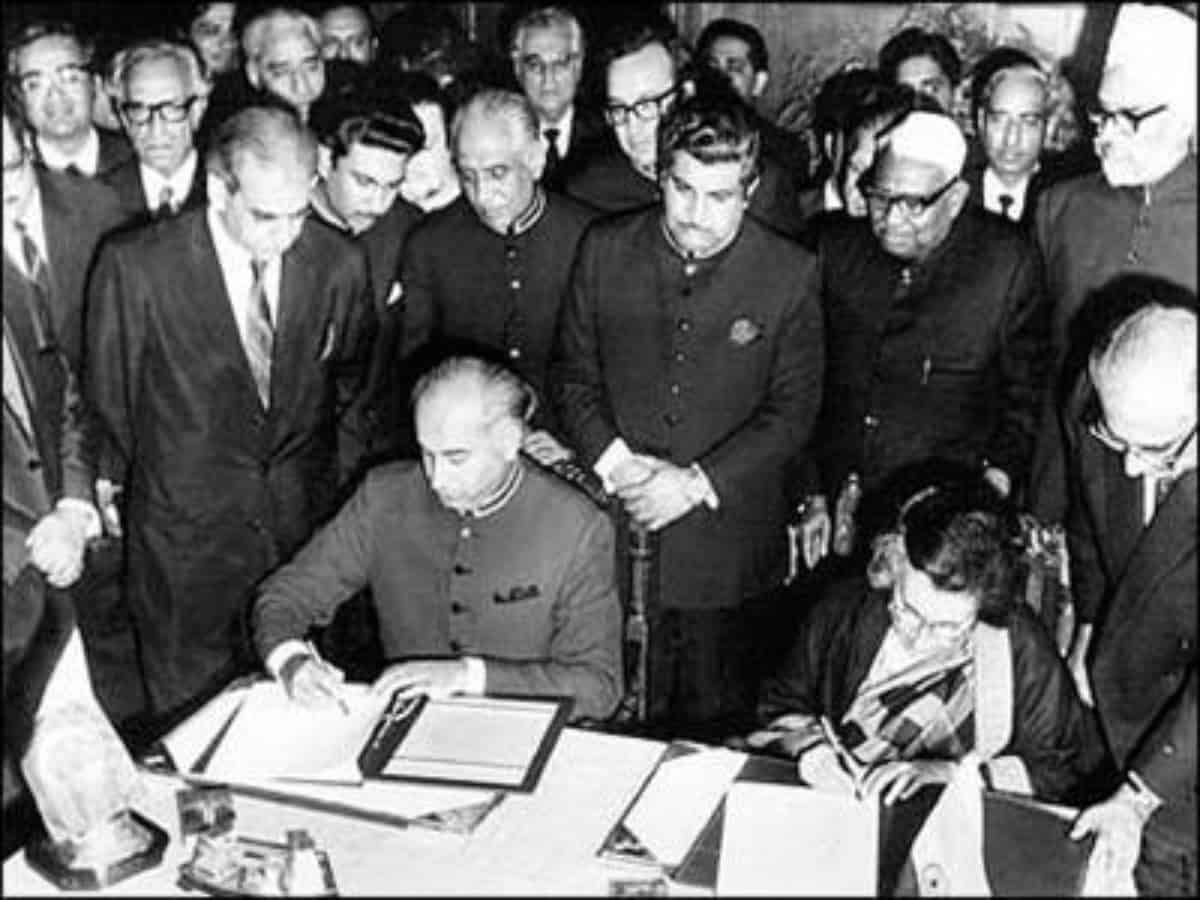
The Shimla Agreement, whose Golden Jubilee falls on July 2, 2022, set a new paradigm in the Indian Foreign Policy. The Panchsheel of Pandit Jawaharlal Nehru was formulated in the Sino-Indian context. But, it went on to create a new architecture for international relations.
Similarly, the Shimla Agreement, signed after the Indo-Pakistan War that ended on December 16, 1971, following the Liberation of Bangladesh, by the two leaders, Prime Minister Indira Gandhi and Pakistan President Zulfiqar Ali Bhutto, on July 2, 1972, is considered a landmark.
It has become a milestone, not just in India, Pakistan relations, but also for the peace and security in South Asia. It was the triumph of statesmanship of Indira Gandhi. Drawing lessons from the Treaty of Versailles and how it became the trigger for the Second World War, Indira Gandhi decided to talk across the table with Pakistan President Zulfiqar Ali Bhutto and made it binding on both the countries to address and resolve all outstanding issues in the bilateral mode.
The Shimla Agreement states: “That the two countries are resolved to settle their differences by peaceful means through bilateral negotiations or by any other peaceful means mutually agreed upon between them. Pending the final settlement of any of the problems between the two countries, neither side shall unilaterally alter the situation and both shall prevent the organization, assistance or encouragement of any acts detrimental to the maintenance of peaceful and harmonious relations.”
Taking J&K Issue to UN
Soon after Indian Independence on August 15, 1947, a Hindu, not Muslim King of Jammu & Kashmir, Maharaja Hari Singh, refused to join the Indian Union.
Within two months of the Indian Independence, Pakistan attacked India on October 22, 1947. Pandit Jawaharlal Nehru sent the Indian Army to push back the Pakistani attack, within hours of Jammu & Kashmir Maharaja Hari Singh signing the Instrument of Accession on October 26, 1947. On January 1, 1948, Jawaharlal Nehru took the issue to the United Nations Security Council, to register a complaint of wanton aggression by Pakistan against India.
The demand was for the vacation of Pakistani Aggression on the Indian State of Kashmir. This only strengthens the Indian case, when a complaint of external aggression is lodged with the UN Security Council.
Sangh Myth
Only Jan Sangh leader Atal Behari Vajpayee could come up with a comical theory that the Kashmir issue has been internationalized by Nehru’s action. And Vajpayee succeeded in creating the myth that Nehru committed a blunder, which persists to date.
Surely Vajpayee does not understand the nitty-gritty of the United Nations Charter or the UN functioning.
In fact, initial UN Resolutions were all favourable to India. But from 1950 onwards, Western Powers, the United States, and the United Kingdom, saw a scope to gain a foothold in the region by backing Pakistan on the Kashmir issue.
India became a victim of the Cold War between the Western and the Eastern Blocs. Pakistan joined the Western Military Alliance, but India remained committed to the policy of Non-Alignment.
Importance of Shimla Pact
It was against this backdrop that Indira Gandhi in 1972 decided to take Kashmir away from UN purview. In the Shimla Agreement, Indira Gandhi got, not just the Jammu & Kashmir issue, but all outstanding issues, into the bilateral mode. And Pakistan accepted it.
Particularly, Jammu & Kashmir was delinked from the UN and firmly put in a bilateral format. That was quite an achievement for Indira Gandhi.
Later, the UN also dropped Jammu & Kashmir from its agenda. This remained so till 1998, when the then Prime Minister Atal Behari Vajpayee conducted the Nuclear Test for Weaponisation on May 11 and May 13, 1998. It provoked Pakistan to go nuclear.
Until then, India had an advantage in a conventional war. But with both countries going nuclear, India lost her tactical advantage of edge in a conventional war; besides, the Kashmir issue got instantly internationalized, thanks to Vajpayee.
Vajpayee Targets Shimla Pact
Then came the determined bid for Lahore Summit in February 1999, and Agra Summit in July 2001. Primarily, these were planned with a view to making Shimla Agreement irrelevant. But that stratagem of the BJP did not quite succeed.
Ever since he to power in March 1998, the then Prime Minister Atal Behari Vajpayee targeted Shimla Agreement and wanted to bring about a New Indo-Pak Agreement, which will become the new frame of reference in bilateral relations, thereby reducing the Shimla Agreement to irrelevance.
The Bus Diplomacy and Lahore Declaration of February 22, 1999, was the first attempt. Not satisfied, he tried the Agra Summit in July 2001, which collapsed midway.
Vajpayee kept trying till he laid down office in May 2004. The last attempt made by Vajpayee was India, Pakistan Joint Statement on January 6, 2004, on the sidelines of the SAARC Summit in Islamabad. Nothing succeeded for him.
For 50 long years, it is Shimla Agreement, the way, which continues to be relevant.
Treaty of Versailles
In 1972, the then Jan Sangh leader Atal Behari Vajpayee assailed Indira Gandhi for handing over 93,000 Pakistan Army Prisoners of War (PoWs) to Pakistan, instead of using them as a bargaining chip to derive tactical benefits. Importantly, India and Pakistan are governed by the United Nations Charter and the Geneva Conventions.
Mahatma Gandhi once famously remarked, “An eye for an will leave the whole world blind.” In a similar vein, even Indira Gandhi detested the attitude of an eye for an eye, a tooth for a tooth..
Speaking in the Rajya Sabha on the Foreign Minister’s Statement on Shimla Agreement on August 2, 1972, Indira Gandhi said, “That is not a mature attitude, which in today’s world can be advantageous to our country. Neither is the spirit of bargaining, which another Hon friend has advised. We are not out to bargain. We are a mature people, who have only one aim before us and that is how to make our country strong. … And when we talk of strength, we mean the strength of the people. And that can come only when the people have understanding, when they have the maturity and when the affairs of the nation are dealt with a certain amount of sagacity and foresight.”
It was the statesmanship of Indira Gandhi, who did not pull off another Treaty of Versailles, signed at the end of the First World War on June 28, 1919. Article 231 was considered as War Guilt Clause. It humiliated Germany so much that in less than two decades, Germans regrouped as the most formidable nation, triggering the Second World War.
Speaking in Lok Sabha in a debate on the statement on Agreement on Bilateral Relations Between India and Pakistan on July 31, 1972, Indira Gandhi said, “As some historian has said, ‘Had the countries of Europe treated Germany with the understanding that India has shown Pakistan, there would not have been a Hitler and there would not have been a Second World War’.”
No-War Pact
The No-War Pact, offered ever so many times by Pandit Jawaharlal Nehru and later by Indira Gandhi, but rejected out of hand by Pakistan, was crystallized in the Shimla Agreement. Outlawing the use of force to settle international disputes, Indira Gandhi made it binding on Pakistan to settle all outstanding disputes in bilateral mode.
It is a landmark accord, which, in one stroke, took away Kashmir from the United Nations and brought it into bilateral mode. Pakistan was persuaded to give up its insistence on Third-Party mediation and to settle all outstanding issues with India in the bilateral format.
Kashmir Solution
Shimla Agreement set the framework for what appears to be the logical solution to the Kashmir issue. That is to convert Line of Control (LoC) into International Border (IB). Logically, it is the Kashmir Valley that still retains its Kashmiri character, as the Pakistan-Occupied Kashmir (POK) has undergone a sea-change in its demography.
After the Pakistani surrender in Dhaka on December 16, 1971, Indira Gandhi declared Unilateral Ceasefire on the Western, Pakistani front, on December 17, 1971.
This Ceasefire Line of December 17, 1971, was converted into the Line of Control in 1972. Rhetoric notwithstanding, there is only one logical, practicable and viable solution to the Kashmir issue, of converting the Line of Control (LoC) into an International Border (IB).
Pakistan President Zulfiqar Ali Bhutto sought time to go back to Pakistan to bring the political establishment on board, before formalizing the Agreement.
Apparently, Bhutto did not receive the necessary political backing from the Pakistani Establishment. As a result, Bhutto backed out, after agreeing to resolve the Kashmir issue, during the Summit in Shimla.
Indira Gandhi Vision
For Indira Gandhi, poverty was the principal enemy and not any particular country. She wanted friendship with all countries, especially in the immediate neighborhood. Her idea was that peace is a necessary precondition for fighting against poverty and achieving progress and prosperity.
It was with this approach that Indira Gandhi extended, a number of times, the hand of friendship to Pakistan. But each time, it was met with a clenched fist.
The Shimla Agreement finally paved the way for putting behind all bitterness and rivalry between India and Pakistan. With that, the single-minded focus would be on engaging in the gigantic task of economic growth and social development. Therein lies the significance of the Shimla Agreement.

